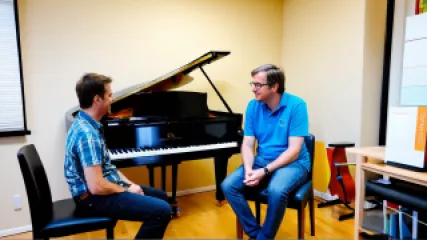How Music Therapy Transformed My Communication Skills
How Music Therapy Transformed My Communication Skills
My name is Lee Owen, and I'm here to share my personal journey of how music therapy has profoundly impacted my life, particularly in the realm of communication. As someone who has always struggled with expressing myself and connecting with others, I never imagined the transformative power that music could have on my ability to communicate effectively.
Growing up, I was a shy and introverted individual, often finding it challenging to articulate my thoughts and feelings. Social situations would fill me with anxiety, and I would frequently retreat into my own world, avoiding interactions whenever possible. This isolation only exacerbated my communication difficulties, as I lacked the practice and confidence needed to engage in meaningful conversations.
It wasn't until I stumbled upon the concept of music therapy that my perspective began to shift. I had heard about the benefits of music on mental health and well-being, but I never fully understood the depth of its impact until I decided to give it a try.
Discovering the Power of Music Therapy
At first, I was hesitant to participate in music therapy sessions. The idea of engaging with music in a therapeutic setting felt foreign and somewhat intimidating. However, the more I learned about the approach and the experiences of others who had benefited from it, the more intrigued I became.
The turning point came when I attended my first music therapy session. I'll never forget the sense of trepidation I felt as I walked through the doors, unsure of what to expect. But from the moment I sat down and the therapist began to guide me through various exercises, I felt a shift within me.
The therapist, whose name was Caleb, had a warm and welcoming presence that immediately put me at ease. He explained that the sessions would be a safe space for me to explore my emotions and express myself through music, without any pressure or judgment.
Caleb began by encouraging me to tap into my senses, asking me to close my eyes and listen to the soothing melodies he played on the piano. As I allowed the music to wash over me, I felt a sense of calm wash over me as well. It was as if the music had the power to quiet the constant chatter in my mind and open me up to a new way of being.
Finding My Voice Through Music
Over the course of the following sessions, Caleb introduced me to various musical instruments and techniques that were designed to help me explore my inner world and enhance my communication skills. One of the first exercises he had me try was improvising on the guitar.
At first, the idea of creating my own music felt daunting and overwhelming. I had never played an instrument before, and the thought of producing something meaningful and coherent seemed impossible. But Caleb's gentle encouragement and the supportive environment he had created gave me the courage to try.
As I strummed the guitar strings, I felt a surge of emotions begin to surface. Emotions that I had long suppressed and struggled to articulate. Suddenly, the music became a conduit for my innermost thoughts and feelings, allowing me to express myself in ways I had never experienced before.
With each session, I found myself becoming more and more comfortable with the musical instruments and the process of self-expression. Caleb would often invite me to improvise melodies or rhythms that reflected my current state of mind, and I was amazed by how easily the music flowed from me.
It was as if the music had unlocked a part of myself that had been dormant for years. I began to feel more connected to my emotions, more attuned to the nuances of my own internal experiences. And as I grew more confident in my ability to express myself through music, I found that this newfound self-awareness was spilling over into my everyday life.
Improving Communication Skills through Music Therapy
One of the most profound changes I experienced during my music therapy journey was the way it transformed my communication skills. As I became more adept at expressing myself through music, I found that I was also gaining the confidence and tools to articulate my thoughts and feelings in my day-to-day interactions.
The act of improvising and creating music together with Caleb taught me the importance of active listening and being present in the moment. I learned to pay attention to the nuances of the music, to respond to the subtle shifts in tempo and melody, and to engage in a true back-and-forth exchange.
This practice of attentive listening and responsive communication carried over into my personal relationships as well. I found myself becoming a better listener, more attuned to the needs and emotions of the people around me. I was able to engage in deeper, more meaningful conversations, and I felt a stronger sense of connection with my friends, family, and colleagues.
Moreover, the act of creating music together with Caleb and the other participants in the music therapy sessions fostered a sense of community and shared understanding. We were all on a journey of self-discovery and growth, and the music became a unifying force that brought us together.
In these sessions, I learned the importance of collaboration, compromise, and understanding. I discovered that communication is not just about transmitting information, but about creating a shared experience and building genuine connections with others.
The Lasting Impact of Music Therapy
As I look back on my music therapy journey, I am filled with a profound sense of gratitude and wonder. The transformation I have experienced in my communication skills and overall well-being is truly remarkable.
I no longer struggle with the crippling anxiety and isolation that once defined my life. Instead, I have developed a newfound confidence and ability to engage with the world around me. I am more self-aware, more attuned to my emotions, and more skilled at expressing myself in meaningful ways.
But the impact of music therapy extends far beyond my personal growth. It has also had a ripple effect on my relationships, my work, and my sense of purpose in life.
In my work as a [occupation], I have found that the skills I've developed through music therapy have been invaluable. I am better able to listen to my clients, to understand their needs, and to communicate in a way that is both empathetic and effective. The music therapy exercises have taught me the importance of creative problem-solving and the power of non-verbal communication.
Moreover, the sense of community and connectedness that I experienced in the music therapy sessions has carried over into my personal life. I have developed deeper, more meaningful relationships with my friends and family, and I find myself more invested in the well-being of my community as a whole.
Looking back, I can say with certainty that music therapy has not only transformed my communication skills but has also profoundly impacted the trajectory of my life. It has given me a renewed sense of purpose, a deeper understanding of myself, and a greater appreciation for the power of human connection.
If you are struggling with communication challenges, I would encourage you to consider exploring the world of music therapy. It may just be the transformative experience you need to unlock your full potential and cultivate the meaningful connections you deserve.
In conclusion, my journey with music therapy has been a transformative and life-changing experience. Through the power of music, I have discovered a new way of expressing myself, connecting with others, and navigating the complexities of communication. The skills and insights I have gained have had a lasting impact on my personal and professional life, and I am forever grateful for the opportunity to have embarked on this journey.
If you are someone who has struggled with communication challenges, I hope that my story has inspired you to consider the potential of music therapy. It may just be the key to unlocking a whole new world of self-discovery, personal growth, and meaningful connections. Remember, the power of music is truly boundless, and with the right guidance and support, it can become a powerful tool for transformation.
So, don't hesitate to explore the world of music therapy and see how it can help you on your own journey of self-discovery and communication. Who knows, it may just be the catalyst for the kind of positive change that you've been searching for all along.






